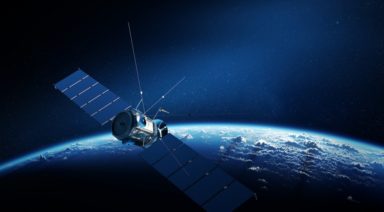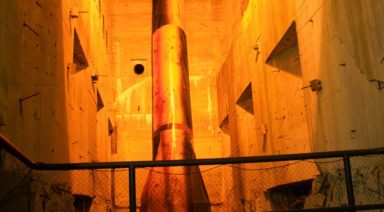Professor Predicts Binary Star Collision Will Light Up Night Sky

In 2022, a binary star system will merge creating a massive explosion visible from Earth by the naked eye. Astronomers say this stellar collision in the Cygnus system will create what’s known as a red nova, in the first ever predicted collision of a binary star system.
These stars, known as KIC 9832227, are an eclipsing system, meaning they’re locked in a cosmic dance around each other, observed to have grown shorter over the past five years. The stellar companions were first observed by Calvin College professor, Lawrence Molner.
Molner is monitoring the system with a low budget and relatively small telescope to predict the stars’ collision. He says typically observations of this magnitude involve billions of dollars and teams numbering in the thousands. But rarely will a phenomenon such as this achieve that level of funding, due to the low probability of prediction accuracy.
“It’s a one-in-a-million chance that you can predict an explosion,” Molner said. “It’s never been done before.”
Though binary mergers like this have been observed before, it’s usually after the fact. If Molner’s prediction holds up it will be a first. The only other red nova to have been observed after a collision was by astronomer Romuald Tylenda, in 2008.
When the two stars eventually collide, they will produce what’s called a luminous red nova – an explosion that releases energy tantamount to all of the energy our sun will release in its entire lifetime, and it will be visible without a telescope for up to a month.
After the merge, the stars will join to form a larger, hotter main sequence star. The collision will result in an increased brightness of ten thousand fold and will glow bright in the Cygnus swan constellation.
When Molner talks about predicting the stars collision, it’s actually about predicting something that has already happened, nearly 2000 years ago. That’s because this binary star system is 1,800 light years away from us, so Molner is predicting that these stars collided 1,800 years ago and the light emitted from them will reach is in about four more years.
Molner admits he doesn’t really know whether the stars collided or not, it’s simply a prediction. He said we weren’t supposed to discover this system and that it essentially happened by chance. But if he’s right, he’ll make history.
Project Serpo and the Zeta Reticuli Exchange Program

In November 1977, Steven Spielberg released his movie, “Close Encounters of the Third Kind.” It was a financial and artistic success. It received a number of accolades, including nominations for four Golden Globes and eight Academy Awards. In 2007, the U.S. Library Of Congress deemed the film “culturally, historically and aesthetically significant” and chose it for preservation in the library “for all time.” Read the purported story of Project Serpo, then consider the evidence.
UFO Encounter Classification
For those new to the topic, the title of Spielberg’s movie came from the UFO classification developed by astronomer and UFO researcher, J. Allen Hynek’s Classification of UFO encounters: + Encounters of the first kind: Someone sees a UFO at a distance closer than 500 feet and is able to give a pretty good description of the object + Encounters of the second kind: The viewing of an UFO creates a physical sensation. For example, the encounter may involve a feeling of heat, or a feeling of paralysis in the body + Encounters of the third kind: Encounters in which a type of “animated creature” accompanies the UFO encounter.
Hynek was an Advisor to the U.S. Air Force on several of its UFO study projects. While he was bound by security clearances, he was undoubtedly privy to information that he was unable to share publicly. He also had a cameo appearance in the Spielberg movie.
In the movie, there are human encounters with extraterrestrials (ETs) and, in the end, one person voluntarily decides to join the ETs and travel with them back to their planet. Could there be any truth to this story? Is it possible that Earth has contacted ETs or that Americans have visited other planets? Read about the Serpo Exchange Program and President Ronald Reagan’s knowledge of Project Serpo.
The Exchange Program Between Earth and Project Serpo In the Zeta Reticuli System
The Planet Serpo exchange project traces its origins to the Famous Roswell Incident where a UFO reportedly crashed in the plains near Socorro, New Mexico, on May 31, 1947. The remains of the craft and one living ET, along with the bodies of his four dead companions, were taken to Roswell for analysis. Meanwhile, the government reported to the American public by telling them they had only seen weather balloons.
As it turned out, there were Two Crashes. The remains of the second UFO were not found until about two years later. It appeared the two spacecraft had crashed into each other. By then, six bodies of dead aliens had decomposed, so there wasn’t much of them left. Even so, the remains were taken to Wright-Patterson Air Force Base for evaluation and study.





































